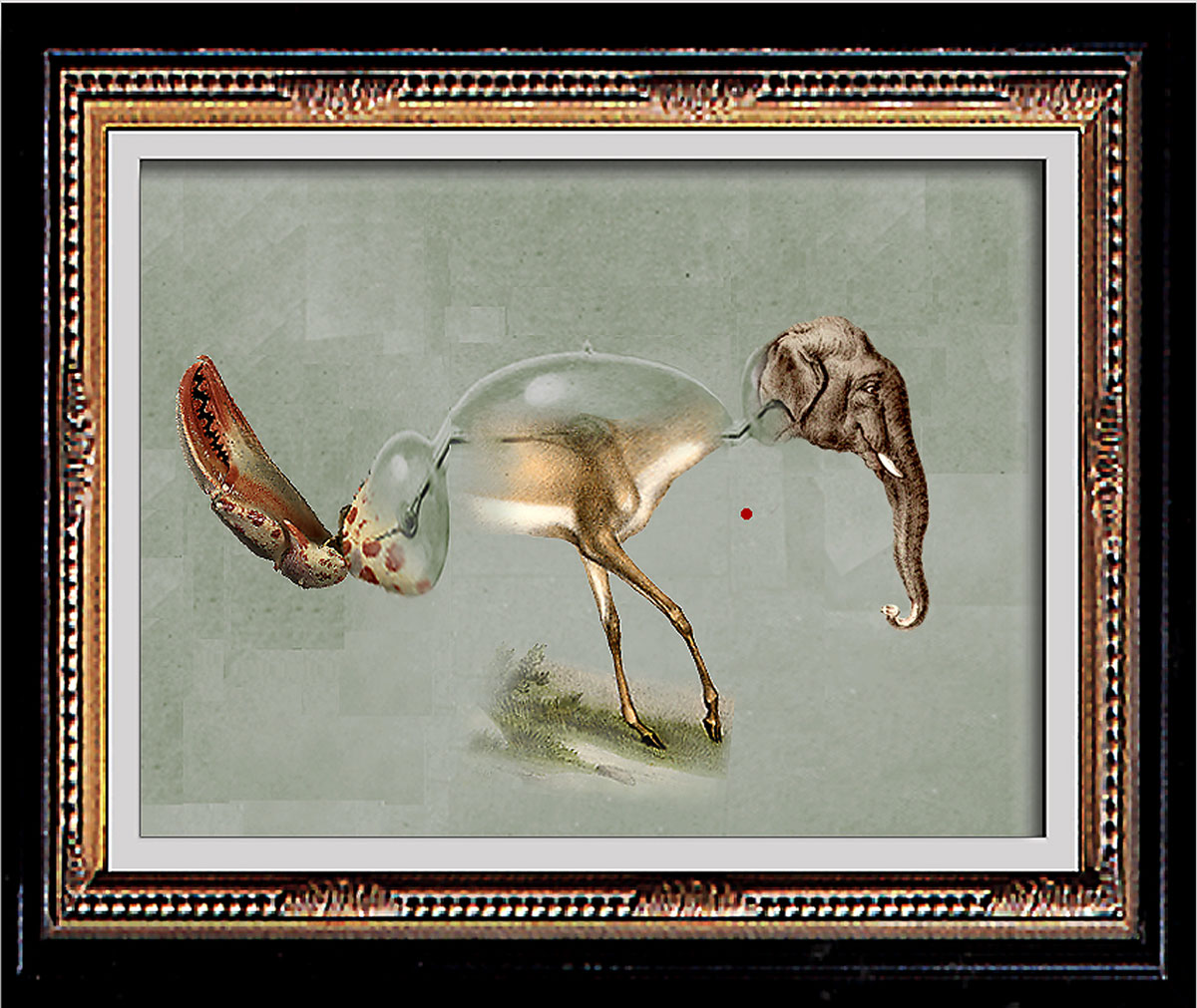Thoughts on Hybrids: Intention and Implementation
Traditional photographs and photorealistic illustrations convince us of their “truth” through their likeness to the real world. In images such as these, lines connect and surfaces are uninterrupted. When changes in form do occur, enough connectedness remains at transitional boundaries to prevent the image’s “breaking” into fragments. Its parts add up to create an understandable whole; a whole which represents a believable window on reality. This illusion of realness is very powerful. It explains why photographs and photorealistic images are ubiquitous. It explains the power and persistence of photojournalism and portraiture.
In the installation called “Hybrids” I utilize the believability of photographs and highly realistic illustrations to construct a portrait of an imaginary animal. This animal, a mutated, hybridized monster, represents the result of a genetic engineering experiment gone awry. It is fastened together through laboratory vials which serve to connect various body parts harvested from a menagerie of different animals.
The result harkens back to historical monsters; centaurs, minotaurs, sphinxes and other hybridized creatures from past myths and legends. (The devils with animal appendages from “Gebrueder Grimm” and “Bechstein’s Maerchen”, read to me in the original German when I was a child, are a particular inspiration, as well as characters from “Grandville’s Animals” and, of course, “Alice in Wonderland”.)
Though fairy-tale-like in appearance, this animal hybrid actually symbolizes present day fact. The fact that scientific intervention, control and manipulation of living organisms is no longer fiction. The strangely fascinating examples of cloned sheep and bioluminescent mice (injected with genetic material from deep-water jellyfish) as well as the now countless instances of genetically tailored flies, rats, pigs and cows merely underscore the point. Hybrids such as this one, be they grotesque, humorous or simply odd, are an increasingly real possibility.
It is not my intention to imply that science should or could be stopped in its tracks, lest we create un-natural nature. I am merely stopping to imagine the absurd and surprising results obtained by tweaking the zoo of life in the name of enlightenment and progress. In this work, the implementation of an “interactive print” is used to express the idea of scientifically spawned hybrids, as follows:
Traditional prints are typically mounted on a wall inside a decorative, (or at least protective) frame. Frequently, a matboard provides the spatial transition between frame and print. A viewer looking at such an arrangement has certain expectations: the print is flat, usually behind the frame and mat. The image in the frame is immutable. It cannot move or change.

In this work, I seek to add an element of mutability to the static print; a mutability which allows for changes in the image to take place through viewer (user) interaction. The “print” is actually an LCD flat-panel monitor, connected to a computer. By simple manipulation of a mouse (on a pedestal in front of the print), the viewer can alter parts of the image. The resulting image variations retain the spatial continuity of the whole, thereby also retaining the illusion of the static print. The technology which allows the alteration of the image must be concealed (behind a false wall.) It is essential that the installation look traditional; “properly” matted and framed. The viewer’s expectations should be that she will encounter a static print, not that she will interact with a computer or watch a video monitor. An element of surprise results from the discovery that the print is not static but changeable and that a randomized set of animal noises are emitted when the print is “played”. These loud, incongruous sounds add another element of nonsensical juxtaposition to the viewer’s experience.
Shifts in meaning occur when one part of the image changes in relation to the whole. Different parts add up to mean different things. In this piece, the parts (animal heads, torsos and hind legs juxtaposed at wildly varied scale) flip by like the images in a surrealist slot machine, always resulting in the “winning” combination of a whole animal. In this process of random selection, nothing is missing, and yet things don’t quite add up. The resulting tension between wholeness and fragmentation (hopefully) engages the viewer to intervene again, much in the way that a successful experiment motivates the scientist into further exploration. This constitutes a kind of gameplay, the goal being to entertain oneself with a continuous stream of unexpected results. An implied narrative exists, in which the viewer imagines explanatory stories. (How does this creature walk or fly? How does it sound, eat or procreate? How might it feel?)
Any interactive system which offers changeability also raises the question of authorship. Although the choices for change available to the viewer are finite (because they are contained within the software’s finite database), the viewer is able to leave the image in an altered state. The capacity for viewer intervention, even in a deterministic system, undermines the a priori control which artists have traditionally had when creating static work. Not all decisions are made by the author in advance. The author provides the context, in the form of an “aesthetic system”, but some, and potentially many, choices are made after the fact, by the viewer. It is this act of intervention, represented in this work as a simple click of the mouse, which I believe not only mimics the manipulation, by contemporary science, of the mechanisms of living things, but also symbolizes the eternally irrepressible drive to intervene in nature, which is a fundamental characteristic of being human.
